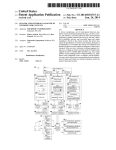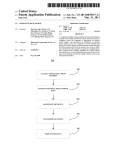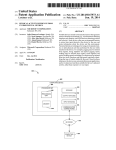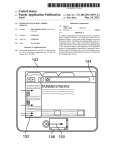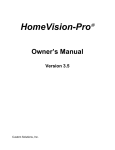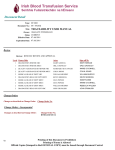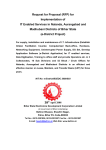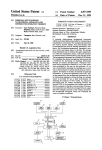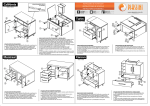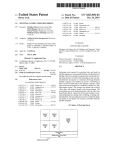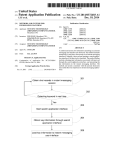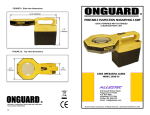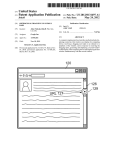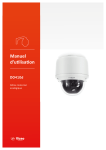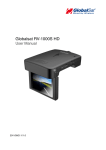Download 102B/`II
Transcript
US 20130082935A1 (19) United States (12) Patent Application Publication (10) Pub. No.: US 2013/0082935 A1 Duggan et al. (54) (43) Pub. Date: DYNAMIC COMMAND PRESENTATION AND KEY CONFIGURATION FOR KEYBOARDS Apr. 4, 2013 Publication Classi?cation (5 1) Int. Cl. G06F 3/02 (75) Inventors: Finbarr Duggan, Bray (IE); Seung (52) Yang, Woodinville, WA (US); Gerrit i/048 ‘ ‘ Hofmeesters WOOdinV?1e’WA(US); (2006.01) (200601) ‘ _ USPC ......................................... .. 345/172, 715/773 Vasudha Chandrasekaran, Mountain (57) ABSTRACT Techniques involving selective modi?cation of keyboard pre sentation and functionality. A commanding mode is selec View, CA (U S) tively activated on a virtual keyboard. Activating the com (73) Assignee: Microsoft Corporation, Redmond, WA manding mode attributes commands to respective individual (Us) keys of the virtual keyboard. Also in response to the com manding mode, indicia suggestive of the command is pre sented on those individual keys to Which the commands Were attributed. The commands can be executed in an application (21) App1.No.: 13/249,258 (22) Filed: in response to selection of the respective individual keys When in commanding mode. Sep. 30, 2011 100 COMPUTING APPARATUS 10 1’8 TOUCH-BASED KEY ENTRY MODULE COMMANDING MODE ACTIVATION 102B/‘II KEY COMMAND CONFIGURATION A E’ 116KEYBOARD LAYOUT ‘El; 120A / KEYBOARD LAYOUT WITH 12 124\k 120B COMMANDS | COMMAND 122 DISPLAY & USER INPUT xxx/ v FUNCTION '\ 126 APPLICATION 106 / Patent Application Publication Apr. 4, 2013 Sheet 1 0f 7 US 2013/0082935 A1 100 COMPUTING APPARATUS 104 102 108 TOUCH-BASED KEY ENTRY MODULE / 102E111 110 COMMANDING f MODE ACTIVATION KEY COMMAND CONFIGURATION 118 f 1 16 KEYBOARD LAYOUT IEIQOA 1 1/2 , 08 KEYBOARD LAYOUT WITH IEII 120B COMMANDS COMMAND 12/2 DISPLAY & USER INPUT xxx/ V FUNCTION \ 126 APPLICATION / 106 FIG. 1 P Patent Application Publication 200 \ Apr. 4, 2013 Sheet 2 0f 7 US 2013/0082935 A1 1' 202A \\\ I I ‘I,’ 200 \‘ I I I]; I I’ ' I’ I 202B 5 I ' 204A I § S Save 2048 s save s Lt] La) big] 2040 204D 204E FIG. 2 s00 ACTIVATE COMMANDING MODE f ‘V ATTRIBUTE COMMANDS TO RESPECTIVE f 302 INDIVIDUAL KEYS OF A VIRTUAL KEYBOARD 304 v H PRESENT INDICIA ON THE INDIVIDUAL KEYS OF THE VIRTUAL KEYBOARD TO WHICH COMMANDS ARE ATTRIBUTED, IN RESPONSE TO ACTIVATION OF THE COMMANDING MODE 306 V ENABLE EXECUTION OF COMMANDS IN RESPONSE TO SELECTION OF THE COMMANDS’ RESPECTIVE INDIVIDUAL KEYS WHEN IN COMMANDING MODE FIG. 3 H Patent Application Publication Apr. 4, 2013 Sheet 3 0f 7 US 2013/0082935 A1 52:9m0\0.% Patent Application Publication Apr. 4, 2013 Sheet 4 0f 7 US 2013/0082935 A1 < CD % g 0 I 0 K LIJ E § E 5 "a D: £5 3 15 E E g Lr) 3 Lo <1 s Lo 03 j < '6 "_'|J LIJ (D 8 I!) Patent Application Publication Apr. 4, 2013 Sheet 5 0f 7 604 / / OPERA-[MG SYSTEM US 2013/0082935 A1 602 600 / LANGUAGE ONSCREEN KEYBOARD 608 / COMMAND “ITALICS" 606 610A 6105 K ENGLISH | —> | —> 612 612 IE3 K PANI H ITALICS CURSIVA 614A 614B FIG. 6 K 710 SHORTCUT DESCRIPTIONS, IMAGES, ETC. I 708 700 APPLICATION-A I; 702 OPERATING APPLICATION-B I; SYSTEM : KEYBOARD CONFIGURATION ' 704 APPLICATION-n I; FIG. 7A K 710 SHORTCUT DESCRIPTIONS, IMAGES, ETC. 712 V COMMANDS. INDICIA f 700 y f 718 <—| APPLICATION-A |—| KEYBOARD CONFIGURATION-A | COMMANDS, INDICIA OPERAHNG <14/4—| APPLICATION-B |—| KEYBOARD CONFIGURATION-B | 7 Z SYSTEM , K716704 0 . \702 COMMANDS, INDICIA 722\ \720 <—| APPLICATION-n |—| KEYBOARD CONFIGURATION-n | FIG. 7B Patent Application Publication Apr. 4, 2013 Sheet 6 0f 7 US 2013/0082935 A1 | PRESENT TOUICH KEYBOARD I\ 800 I 800 _/ I CONFIGURE BASED ON THE APPLICATION BEING USED CONFIGURE BASED ON THE x 802 OPERATING SYSTEM BEING USED V TOUCH CTRL KEY TO ACTIVATE COMMANDING MODE \ s04 \ DETERMINE LANGUAGE OPERATING 206A KEYBOARD F 806B INSTALLATION SYSTEM \ 806 808 V DYNAMICALLY PRESENT ONE OR MORE COMMAND IDENTIFIERS ON ONE OR MORE RESPECTIVE KEYS IN RESPONSE TO THE COMMANDING MODE BEING ACTIVATED AND THE DETERMINED LANGUAGE 810 WHILE IN COMMANDING MODE, ASSOCIATE A COMMAND KEYSTROKE SEQUENCE WITH EACH OF THE KEYS IN WHICH A COMMAND IDENTIFIER HAS BEEN PRESENTED 812 NO KEY HAVING COMMAND IDENTIFIER TOUCH ED? SEND COMMAND KEYSTROKE SEQUENCE RECOGNIZABLE BY THE KEYBOARD STACK IN RESPONSE TO KEY WITH THE COMMAND IDENTIER BEING TOUCHED EXECUTE COMMAND IDENTIFIED BY THE TOUCHED COMMAND IDENTIFIER AT THE APPLICATION V REVERT KEYS BACK TO DEFAULT FUNCTION FIG. 8 \ 816 Patent Application Publication moNw 8a 8mVI \z?mo lg k 5N8105 f008< Apr. 4, 2013 Sheet 7 0f 7 US 2013/0082935 A1 Apr. 4, 2013 US 2013/0082935 A1 DYNAMIC COMMAND PRESENTATION AND KEY CONFIGURATION FOR KEYBOARDS executed the instructions can recogniZe that the commanding mode has been enabled by selection of the modi?er key, and BACKGROUND respective keys of the touch keyboard. The instructions can recogniZe that a key that has a command identi?er presented in response, can dynamically present command identi?ers on [0001] Physical keyboards and on-screen keyboard emula tors may enable keyboard commanding, Which allows com mands to be performed in an application by pressing a com bination of keys or representations of such keys. For example, holding a modi?er key (e.g. Ctrl) While concurrently pressing a character or “shortcut” key can cause a command to be performed. Such commands may be able to be accessed in other Ways, such as via a graphical user interface (GUI) menu, icon or other manner, Where keyboard commanding enables commands to be reached by pressing key combinations. [0002] Keyboard commanding may improve on GUI com manding via mouse or on-screen commanding as no special keys for commands are needed, as existing physical or on screen keys can be utiliZed Without needing additional Work ing space. Further, users do not need to remove their hands on it has been selected, and in response, provide a series of keystroke actions to a keyboard stack to carry out a command identi?able by the command identi?er of the selected key. The instructions may further disable the commanding mode to return the touch keyboard to its state prior to enabling of the commanding mode. [0007] This Summary is provided to introduce a selection of concepts in a simpli?ed form that are further described beloW in the Detailed Description. This Summary is not intended to identify key features or essential features of the claimed subject matter, nor is it intended to be used to limit the scope of the claimed subject matter. BRIEF DESCRIPTION OF THE DRAWINGS from the keyboard, Which may improve input e?iciency. [0008] [0003] computing apparatus that incorporates virtual keyboard Notwithstanding some bene?ts to keyboard com manding, keyboard commanding systems suffer from a dis coverability issue, Where keyboard shortcuts for commands FIG. 1 is a block diagram depicting a representative based commanding in accordance With the disclosure; are dif?cult for users to discover and learn. In on-screen [0009] FIG. 2 depicts an example in Which a command is associated With and presented on a key in connection With a environments, this may result in the use of dedicated on commanding mode; screen elements despite the availability of keyboard-based commanding. Additionally, modi?er keys can serve various purposes in physical keyboards that Would be inappropriate or dif?cult in a keyboard optimiZed for touch, and leveraging an input system designed for physical keyboards may there [0010] FIG. 3 is a How diagram of an exemplary manner for identifying command shortcuts on a virtual keyboard; [0011] FIG. 4 depicts another example for identifying com mand shortcuts on a virtual keyboard; [0012] FIGS. 5A and 5B illustrate representative keyboard layouts that depict the dynamic command assignment and command key identi?cation described herein; fore be ineffective. SUMMARY [0004] Techniques involving selective modi?cation of key board presentation and functionality. One representative computer-implemented technique includes activating a com manding mode on a virtual keyboard. Activating the com manding mode attributes commands to respective individual keys of the virtual keyboard. Also in response to the com manding mode, indicia suggestive of the command is pre sented on those individual keys to Which the commands Were attributed. The representative technique further involves enabling execution of the commands in a processor-imple mented application in response to selection of their respective [0013] FIG. 6 is a block diagram that illustrates examples of adapting the shortcuts based on keyboard language When in commanding mode ; [0014] FIGS. 7A and 7B illustrate examples of implement ing dynamic shortcut keys using system-level and applica tion-level commands respectively; [0015] FIG. 8 is a How diagram illustrating alternative method features in connection With the command assignment and descriptions; and [0016] FIG. 9 depicts a representative computing system in Which the principles described herein may be implemented. DETAILED DESCRIPTION individual keys When in commanding mode. [0005] Another representative implementation involves an [0017] apparatus that includes at least a touch-based keyboard and a the accompanying draWings that depict representative imple processor. The touch-based keyboard includes visually pre mentation examples. It is to be understood that other embodi ments and implementations may be utiliZed, as structural sented keys. At least one of the keys is con?gured as a modi ?er key, and at least one of the other keys is con?gured as a standard key to provide a ?rst function When selected. The In the folloWing description, reference is made to and/or operational changes may be made Without departing from the scope of the disclosure. processor is con?gured to recogniZe that the modi?er key has [0018] been selected, Which initiates a commanding mode. In response to the commanding mode, the processor is con?g ured to present command indicia on the standard key, and to functionality. Often a physical keyboard is associated With a computing system, such as a physical keyboard that connects to a computer Wirelessly or by Way of cabling. Other user recon?gure the standard key to provide, When selected, a different function identi?able by the command indicia. [0006] In yet another representative embodiment, com puter-readable media having instructions stored thereon visual presentations of keyboards, such as presented on a display device, projected on a table or other surface (e.g. projection keyboard), via surface computing, etc. The present Which are executable by a computing system. The executable instructions can present a touch keyboard, and provide a selectable modi?er key on the touch keyboard that is con?g ured to enable and disable a commanding mode. When disclosure may be utiliZed in connection With any collection of selectable indicia generally referred to herein as key boards, that facilitate modi?able visual representations on at least one of the selectable indicia (e.g. keys). The disclosure is generally directed to keyboard entry mechanisms involve virtual keyboards that provide Apr. 4, 2013 US 2013/0082935 A1 [0019] Computer-executed applications typically receive items (eg “keys”) that are visually presented and that col keyboard input such as characters and other input identi?ed lectively provide a manner in Which user input can be achieved. by the key itself. However, applications often facilitate entry of commands or functions that are not speci?cally associated [0023] With a designated key. For example, a function at an operating commanding mode on a virtual keyboard. In one embodi system level or application level may be invoked by pressing ment, activating the commanding mode attributes commands to respective keys of the virtual keyboard. Text, icons, images, a series of keystrokes that serve as a “shortcut” forperforming that function. An example is CTRL+C, Which can copy selected information to an electronic clipboard although the Techniques disclosed herein include activating a colors, photos and/or other indicia may be presented on the keyboard may not have a designated “copy” key. HoWever, keys to Which commands Were attributed, in response to the activation of the commanding mode. The commands can be because such shortcuts involve a series of keystrokes that may not be identi?ed on the keyboard, such keyboard command particular keys. Thus, among other things, the techniques executed by pressing or otherWise activating any of these ing suffers from a discoverability issue. The keyboard short described herein involve touch-based keyboards or other vir cuts for commands are dif?cult for users to discover and tual keyboards that incorporate a commanding mode Where learn. Onscreen and other visually-presented keyboards commands may be associated With individual keys. Text or could present additional dedicated keys for additional com mands, but this could result in an unacceptably large visual other indicia is displayed on the appropriate key on the key board, Which can identify the command(s) to be sent. In some layout that may not signi?cantly alleviate discoverability dif cases, a single key activation (e.g. press) on a virtual keyboard ?culties. When in commanding mode can replicate multiple key presses involved With physical keyboard shortcut commands. Further, applications can provide text descriptions and/or [0020] Another representative problem involves the use of virtual keyboards in input systems designed for physical key boards. Applications may leverage an input system designed for physical keyboards in their application of keyboard-based commanding. Character entry solutions optimiZed for touch other indicia for non-standard shortcuts that can be integrated screens cannot share the same input architecture as traditional into the keyboard, irrespective of the language the text is provided in. Commands can be dynamically synchroniZed With a particular keyboard layout. These and other represen keyboards Without compromising their design, since modi?er tative embodiments are described in greater detail beloW. keys can serve many purposes in physical keyboards Which Would be inappropriate in a keyboard optimiZed for touch. As a result, soft keyboards and other virtual keyboards do not provide commanding or require applications to expose com manding in a neW Way. [0021] The disclosure addresses these and other problems. Discoverability problems are addressed by, for example, dis playing descriptions, images, colors and/or other indicia of the commands on the relevant shortcut keys When command ing mode is engaged. As a result, no on-screen elements [0024] FIG. 1 is a block diagram depicting a representative computing apparatus 100 that incorporates virtual keyboard based commanding in accordance With the disclosure. The computing apparatus 100 may represent, for example, a desk top computer, laptop computer, mobile communication device, smartphone or other mobile telephone, application speci?c computing devices (eg hand-held signature devices, scanners, etc.), or any electronic device capable of presenting a virtual keyboard or other touch-based keyboard to accept user input. The computing apparatus 100 may include a pro Would need to be displayed Within the application. Issues cessor (P) 102 and operating system (OS) 104, through Which involving input systems designed for physical keyboards may be addressed by utiliZing the existing commanding system. applications and other functional modules may be executed. [0025] In the illustrated embodiment, application 106 rep resents a computer application that may utiliZe input from the user by Way of a keyboard. The touch-based key entry module 108 represents an executable module that may operate in connection With, or integrally With, an operating system 104. The representative touch-based key entry module 108 of FIG. 1 facilitates activation of a commanding mode, visual alter To avoid the modi?er issues described above With virtual keyboards, a virtual modi?er key may be provided that oper ates Within the scope of the virtual keyboard, and engages a commanding mode rather than sending a modi?er key touch/ press event. Each shortcut key press on the touch keyboard or other virtual keyboard can Wrap multiple key actions on the traditional keyboard stack to achieve an analogous effect as if using a modi?er based solution on a physical keyboard. ation of a keyboard layout, and the user selection of a com mand(s) using the altered keyboard layout. More particularly, Accordingly, users can get physical keyboard commanding the touch-based key entry module 108 of FIG. 1 includes a that appears to behave as that of a physical keyboard, and applications can get touch or other virtual keyboard com commanding mode activation module 110, Which represents manding Without involving any additional Work to be under mode activation module 110 may be triggered through selec taken. Users do not have to change their posture or move tion of one or more selectable keys or other items on a ?rst his/her hands aWay from the keyboard to a pointing device, keyboard layout 112. The ?rst keyboard layout 112 may be presented via the display and user input device 114, Which and can more readily copy, paste and do other commands Without having to recall a keystroke combination for each command. [0022] Various embodiments beloW are described in terms of onscreen or touch keyboards. It should be recogniZed, a manner of initiating a commanding mode. The commanding represents a touchscreen or other onscreen or projected key board. In one example, the commanding mode is activated by pressing a single modi?er key 11 6 on the ?rst keyboard layout 112, although it could be activated by selecting multiple keys or other user input items. In one particular embodiment, com hoWever, that the description is applicable to any virtual key board or other keyboard capable of con?gurably adapting manding mode is activated by touching a control (CTRL) key visual indicia on one or more keys of the collection of keys. on the ?rst keyboard layout 112. References to touch keyboards, touchscreens, onscreen key boards, touch-based keyboards, virtual keyboards and the like [0026] In another embodiment, the commanding mode may be activated by Way of recogniZable triggering events, is intended to broadly encompass collections of selectable other than those involving a user’s manual selection. For Apr. 4, 2013 US 2013/0082935 A1 example, the disclosure contemplates various “smart” trig [0029] gers that can be based on one or more static and/ or dynamic conditions that Would suggest that one or more command tion module 110 causes the commanding mode to remain in shortcuts may dynamically be presented on certain keys or other UI mechanisms. As an example, the commanding mode activation module 110 may recogniZe selection of text in a document, and may dynamically provide the second key board layout 122 that may include one or more commands that can be used With selected text (e.g., “copy text” com mand). As another example, using arroW keys could present a second keyboard layout 122 that includes one or more navi gational commands. As these examples suggest, While trig gering of the modi?er mode may be effected via a particular designated key(s), it can also be triggered in response to other user actions that suggest that the commanding mode is to be activated. [0027] Another representative trigger is a gesture(s) made by a user via the UI. For instance, a touch gesture on a touchscreen, touchpad or other touch-based mechanism to scroll some direction in a document may provide a second keyboard layout 122 that includes one or more navigational commands (e.g., “go to beginning of document,” “go to end of document,” etc.). Another example may be a touch gesture In one embodiment, the commanding mode activa effect, and consequently the second keyboard layout 122 to be presented, until the modi?er key(s) 116 is no longer being touched/ selected. In another embodiment, the modi?er key(s) 116 may be con?gured as a “sticky key,” Where it toggles on and off upon each successive touch. By activating the com manding mode in this manner, a user can be presented With an altered keyboard vieW that shoWs available commands for selection. Rather than having to remember shortcut combi nations, the user can press the modi?er key(s) 116 to cause the key command con?guration module 118 to temporarily con ?gure one or more keys as command shortcut keys, from Which the user can make a command selection. [0030] As noted above, one embodiment involves main taining the commanding mode if the user continues to touch the modi?er key 116, and is applied to all subsequent shortcut key touches until the modi?er key 116 touch is removed. In another embodiment, a sticky key can be used, Which Will remain in effect until the modi?er key is pressed again to deactivate the commanding mode. In yet another embodi ment, the modi?ed mode can be invoked by touching the modi?er key(s), and Without lifting, sliding to the desired command shortcut key to invoke the action at the command that suggests an attempt to expand or Zoom a document vieW, shortcut key Where the sliding action stops. These examples Where such touch gesture presents various document Zoom are merely representative manners in Which the modi?er key (s) may be used, and do not represent an exhaustive list. As noted above, the commanding mode may so be invoked in manners Where a modi?er key(s) is not used, but rather the triggering is “smart” in that it recogniZes user actions, ges tures or other inputs to invoke the commanding mode. [0031] It should be noted that touch-based key entry mod ule 108 and any associated modules may be executed using softWare operable by a processor, such as the processor 102. HoWever, a touch keyboard or other virtual keyboard may have a dedicated processor(s) associated thereWith, such as commands. As these examples reveal, any desired techniques for triggering the commanding mode may be implemented, including but not limited to manual selection via a user inter face mechanism(s), indirect triggering via touch gestures, automatic triggering through other user input such as text selection, etc. Thus, it should be recognized that descriptions involving any particular triggering technique are equally applicable to other triggering techniques. [0028] When the commanding mode has been activated, one or more keys on the presented keyboard change to serve as shortcut keys for functions other than the default function of those keys. For example, a key command con?guration module 118 recogniZes that the commanding mode has been activated, and con?gures one or more keyboard keys to serve as command shortcuts While in commanding mode. In the example of FIG. 1, the key command con?guration module 118 causes at least one key 120A to represent a command key processor 102B. Unless otherWise noted, references to a pro cessor as used herein refer to a processing module(s) Whether a dedicated processor(s) 102B associated With a virtual key board, touchscreen controller, system level processor(s) 102, and/or other processor. [0032] FIG. 2 depicts an example in Which a command is associated With and presented on a key in connection With a 120B provided via a second keyboard layout 122 With com commanding mode. The representative touch-based or virtual mands. For example, the key 120A of the ?rst keyboard keyboard 200 includes a plurality of visually presented keys layout 112 may be a character key, such as a “C” key. When (referred to generally herein as “keys”), including at least one modi?er key 202A and at least one key 204A (referred to in the modi?er key 116 is selected, the commanding mode acti vation module 110 recogniZes that this modi?er key 116 has been selected, and the key command con?guration module 118 presents a second keyboard layout 122 With the neW command(s) displayed. In the present example, the second keyboard layout 122 may be the same as the ?rst keyboard layout 112, With the exception of added or changed informa this example as a standard key) that is acted on as a result of the modi?er key 202A being activated. In this example, prior to the modi?er key 202A being activated by the user, the standard key 204A represents the “S” character key. When the modi?er key 202A is touched or otherWise selected, the func tion associated With the standard key 204A changes in that it tion on the key 120B relative to the original key 120A. As an example, the “C” on the key 120A from the ?rst keyboard Will noW cause a command to be sent to a keyboard handler layout 112 may be changed to instead or additionally display nal “S” character. In the illustrated embodiment, the modi?ed a command, such as “copy” Which is a command to copy a standard key 204B becomes associated With a “save” com mand to save a document, Which is also Written or otherWise identi?ed for the user on the modi?ed standard key 204B selected portion of a document. When the key 120B is selected by a user, the underlying command 124 is provided to the application 106 (or OS 104, or other target) to perform an associated function 126 for the application 106. For example, if the command 124 represents a “copy” command, text or other data selected in the application 106 Will be copied, such as copied to a clipboard. module or “keyboard stack” (not shoWn) rather than the origi itself The modi?er key 202A may be touched and held, or the modi?er key 202A may be con?gured as a toggle key that remains activated until touched again. [0033] While the text or other indicia (the Word “save” in the current example) may be presented next to or otherWise Apr. 4, 2013 US 2013/0082935 A1 near the modi?ed standard key 204B, in one embodiment the text/indicia is presented somewhere on the face of the modi the commands that are noW available in response to activation ?ed standard key 204B When in commanding mode. Repre sentative modi?ed standard key 204B depicts that the descriptive indicia may be presented in addition to the origi 408 With command vieW may be presented as shoWn at block nal function of the key, Which Was the character “S” in this example. As the function of the key changes to the command during commanding mode, one embodiment involves replac ing the indicia on the key With only the command identi?er as shoWn at key 204C. In yet another embodiment, other indicia of the commanding mode. For example, a keyboard layout 410. In the illustrated embodiment, the keyboard layout 408 has changed such that the functions associated With a plural ity of the keys has changed to noW represent a command rather than a character. For example, the “W” key has changed to depict a description of “close doc” that indicates that the active document in the application Will be closed if the key 412 is selected. While the command “close doc” may be an such as an image or icon may instead or additionally be operating system-level command usable across multiple presented on the key, as depicted by key 204D. In still other embodiments, indicia such as that shoWn by any keys 204B, corresponding to the active application being used With the 204C, 204D may be presented by ?rst softWare such as an operating system. Where the commands are operating sys tem-level commands, the commands associated With keys as a result of entering commanding mode may be available across multiple applications that run on the operating system. [0034] Other indicia such as that shoWn by key 204E may be presented by second softWare, such as by the application to Which the command is being used. For example, the applica tion may register commands that can be used With the appli cation, key associations, and associated descriptive indicia. When commanding mode is activated via the modi?er key 202A/202B, the application’s commands can be associated applications, it may also be an application-speci?c command virtual keyboard. [0038] In the illustrated embodiment, it is assumed that the user has touched key 412, thereby selecting the shortcut key exhibiting the desired command as depicted at block 414. In response, block 416 illustrates an embodiment Where that the sequence of keystrokes is provided that the application Would recogniZe as the selected command if activated on a physical keyboard. More particularly, in one embodiment, the sequence of key manipulations is provided to a keyboard stack 418 or other keyboard handling module that is other Wise used for a hardWare keyboard, thereby obviating any need to have a keyboard stack dedicated to the virtual key With and described on keys, such as key 204E Which may use application-speci?c text, an icon or image, and/ or other board. For example, When the “Wiclose doc” key 412 is pressed, a series of keystrokes shoWn at block 417 may be descriptive indicia to identify the command associated With the key 204E While in commanding mode. delivered to cause the command to be executed at the appli [0035] FIG. 3 is a How diagram of an exemplary manner for identifying command shortcuts on a virtual keyboard. In this example, a commanding mode is activated as shoWn at block 300. This may be accomplished in various manners, such as by touching or otherWise selecting one or more keys of the virtual keyboard. As shoWn at block 302, in response to acti vation of the commanding mode, commands are attributed to doWn press of the CTRL key Which serves as the modi?er key in this example, a doWn press of the “W” key, a release of the cation 422. This series of keystrokes may be, for example, a “W” key, and a release of the CTRL key. Thus, pressing the shortcut key 412 While in command mode essentially mimics a series of keystrokes that Would be performed on a physical keyboard to perform the command, thereby enabling the same keyboard stack 418 to be used. In this manner, the respective individual keys of the virtual keyboard. For virtual keyboard emulates a physical keyboard, and the key example, a “save” command may be attributed to the default “S” key, a “copy” command may be attributed to the default board stack 418 sees the input from the virtual keyboard the “C” key, etc. When in commanding mode, indicia is presented on the individual keys of the virtual keyboard to Which the commands have been attributed, as shoWn at block 304. By presenting the indicia on the keys themselves, a user can easily identify the appropriate key to press in order to effect same as if it had been received from a physical keyboard Where the keystrokes are transmitted as they occur. The key board stack 418 may be separate softWare operating in con nection With the operating system 420, or alternatively may be implemented as part of the operating system 420. [0039] FIGS. 5A and 5B illustrate a representative manner for identifying command shortcuts on a touch keyboard. FIG. the desired command. Block 306 indicates that commands may be executed in response to selection of the commands’ 5A illustrates a ?rst state or ?rst layout 500A of a virtual respective individual keys When in commanding mode. keyboard, Which is assumed to be a touch keyboard imple [0036] mented via a touchscreen in the illustrated embodiment. The CTRL key 502A serves as the modi?er key that activates the FIG. 4 depicts a more particular example for iden tifying command shortcuts on a virtual keyboard. A standard keyboard vieW 400 is ?rst presented, as depicted by the rep resentative keyboard layout 402. Keyboard layout 402 depicts a portion of a standard QWERTY keyboard. In accor dance With the disclosure, a modi?er key(s) 404 is selected as shoWn at block 406. The modi?er key 404 may be a desig nated or neW key on the keyboard layout 402, although in one embodiment a key already on the keyboard layout 402 is used as the modi?er key 404. For example, the control (CTRL) key may be used as the modi?er key. In one embodiment, the CTRL or other modi?er key 404 does not send any output, but rather it changes the output sent by other keys. In other Words, commanding mode in the illustrated embodiment. The ?rst layout 500A of the touch keyboard represents a QWERTY keyboard that includes character keys, including the character keys identi?ed as keys 504A, 504A, 508A, 510A, 512A, 514A, 516A and 518A. [0040] When the modi?er key 502A is touched, the embodiment of FIG. 5B illustrates that it may toggle and remain selected, as depicted by toggled modi?er key 502B. While the modi?er key is selected as depicted by toggled modi?er key 502B, the commanding mode is activated. It should be recogniZed that some embodiments do not involve a toggle, and the user continues to touch the CTRL key 502B in one embodiment it’s effect is to change the payload of the character keys. This is described in greater detail beloW. [0037] When the modi?er key 404 has been touched or to remain in commanding mode. When commanding mode is otherWise selected, the keyboard layout may change to re?ect of the keyboard layout 500B. For example, What Was origi activated, commands are presented on one or more of the keys Apr. 4, 2013 US 2013/0082935 A1 nally the character “A” key 504A becomes a shortcut key The example above assumes that the language 602 is based on 504B With the command “select all” to select all text and/or other information in an active application document. The textual description “select all” 524 is also presented on or Similarly, What Was originally the character “Z” key the language installed on the keyboard 600, but the language of the operating system 604 may alternatively be used as the basis for the language selections. [0046] Shortcut key commands may be associated With any keyboard key, and not only character keys. In some embodi ments, the modi?er key may be used in connection With SHIFT keys, arroW keys, and/or other non-character keys to 506A becomes a shortcut key 506B With the command perform shortcuts. For example, touching the modi?er key “undo” to undo the last action(s) in the active application document, and the text “undo” 526 is also presented. Similar change are shoWn by shortcut keys 508B-518B and their respective textual descriptions 528-538. As can be seen, acti vation of the CTRL 502B key or other modi?er key(s) acti vates commanding mode, Where available commands 524 jump a Word to the right in the application. In one embodi ment, a description can be provided on the right arroW key to indicate this command function When the modi?er key has been selected. Similarly, the use of the modi?er symbol in proximate the key 504B, to assist the user in knowing Which key is to be touched in order to cause the “select all” command to be issued to the application. [0041] 538 are presented on shortcut keys 504B-518B. Selection of any of these shortcut keys 504B-518B Will cause the respec tive command to be provided to the application or other targeted software. [0042] Embodiments described herein relate to a system Where an application can supply text and/or other indicia to describe shortcuts that are not otherWise presented on the keyboard, Which Will then be integrated into the keyboard irrespective of language. Keyboard layouts may differ depending on the language that is to be used, and selection of a language or region may impact the presentation or layout of the keyboard. In accordance With the disclosure, shortcut identi?ers can be presented in the language of the installed keyboard, and may also be presented on different keys for different languages due to the shortcuts potentially being associated With different keys. FIG. 6 is a block diagram that illustrates examples of these features. [0043] A virtual keyboard, such as the onscreen keyboard (e.g. CTRL) and a right arroW key can cause the cursor to combination With a plurality of subsequent keys may also perform an appropriate function, such as a combination of CTRL-SHIFT-ARROW Where ARROW represents either the left or right arroW to select the Word in the direction of the arroW from the position of the cursor. When the last key in the sequence is touched, the Whole command sequence can then be provided to the keyboard handling module, also referred to herein as the keyboard stack, for processing and recognition of the desired command. [0047] Other embodiments account for content direction based on language and the ability to provide shortcut keys to change the direction. Most scripts are Written from left-to right (LTR), although certain scripts (e.g. HebreW, Arabic, etc.) are Written from right-to-left (RTL). Where Writing incorporates characters from both Writing directions, the Writing (and reading) order may change multiple times in a single block of text. Thus, shortcut key combinations may be used to change the Writing order direction. The disclosure contemplates this by emulating a physical keyboard that can 600, can be adapted for language by installing the appropriate use the commanding mode and one or more subsequent key language 602 via the operating system 604. Depending on the language of the keyboard, the shortcut descriptions and/or other indicia presented on keys When in commanding mode strokes to change the Writing direction. For example, in a ?rst scenario Where no RTL languages are installed, When the that the installed language 602 is English 606, and command ing mode has been activated. A representative command for “italics” 608 might then adapt a character key “I” 610A. CTRL or other modify key is selected, the SHIFT keys can be disabled. On the other hand, When a bi-directional language is installed, the left and right shift keys can be modi?ed to LTR and RTL When in commanding mode. In such case, the left SHIFT key Will send CTRL+LEFTSHIFT to sWitch to LTR When the mode key 612 has been touched or otherWise Writing direction, and the right SHIFT key Will send CTRL+ selected, the key 610A is modi?ed to that shoWn by key 610B, RIGHTSHIFT to sWitch to RTL Writing direction. The appro priate direction may be indicated on the shortcut keys in response to the modi?er key being selected. This embodiment represents a conditional change, Where the key alteration is dependent on Which keyboard language is installed. Other may differ. In the embodiment of FIG. 6, it is ?rst assumed Where the command “italics” is displayed on the key 610B. In one embodiment the “I” key 610A is selected to ultimately represent the shortcut key 610B, since a CTRL-I in a physical keyboard toggles the italics feature. In this example, the shortcut key 610B description of “italics” is presented in English 606, as this is the language 602 that has been installed for the onscreen keyboard 600. [0044] It is next assumed that the installed language 602 is Spanish 612, and commanding mode has been activated. A representative command for “italics” 608, Which may corre spond to “cursiva” in Spanish, might then adapt a character key “C” 614A. When the mode key 612 has been touched or otherWise selected, the key 614A is modi?ed to that shoWn by key 614B, Where the command “cursiva” is displayed on the key 614B. In this example, the shortcut key 614B description of “cursiva” is presented in Spanish 612, as this is the lan guage 602 that has been installed for the onscreen keyboard 600. [0045] It should be recogniZed that the language 602 may be determined based on, for example, the language of the operating system 604 or the language of the keyboard 600. conditional key/keyboard changes may also be implemented. [0048] As noted above, the shortcut key commands may be system-level commands, application-level commands, etc. FIGS. 7A and 7B illustrate examples of implementing the dynamic shortcut keys using system-level and application level commands respectively. Referring to FIG. 7A, multiple applications 700, 702, 704 may execute under the control of an operating system 706. In such an embodiment, the key board con?guration 708 of shortcut descriptions 710 When in commanding mode can be applied across each of the appli cations 700, 702, 704. In other Words, Whether using appli cation-A 700 or application-B 702, pressing the modi?er key to activate commanding mode Will, in one embodiment, present the same shortcut commands on designated keys of the keyboard. [0049] In another embodiment, the shortcut key commands may be application-level commands, Where the applications Apr. 4, 2013 US 2013/0082935 A1 themselves or other source registers at least some information for speci?c use With the respective application. FIG. 7B illus trates such an example. Again, the applications 700, 702, 704, and operating system 706 are utilized. In this example, each sequence When the “C” key is touched When in commanding mode. When a key associated With a dynamically presented command identi?er is touched (or otherWise selected) as determined at decision block 812, the command keystroke of the applications 700, 702, 704 registers their commands sequence that is recogniZable by the existing keyboard stack and/or indicia 712, 714, 716 to be presented for these com mands. In another embodiment, the commands themselves is sent as shoWn at block 814. This embodiment assumes that an existing keyboard stack, such as a keyboard stack used in are operating system-level commands, but the descriptions and/or other indicia are registered by each application 700, having to create a different keyboard stack. In such a case, the 702, 704. In the illustrated embodiment, it is assumed that each application 700, 702, 704 registers at least its oWn com mands and corresponding shortcut descriptions or other indi connection With a physical keyboard, is exploited Without command keystroke sequence is provided to mimic that Which Would be provided by a physical keyboard to produce the same command for that application. cia 712, 714, 716 to be presented When in commanding mode. [0054] In such case, each application can have an application-spe identi?er may then be executed at the application as shoWn at block 816. In one embodiment, the keys may revert back to their default state as shoWn at block 818. For example, a key that had been dynamically modi?ed to send a “copy” com mand may revert to a “C” character key in response to a ci?c keyboard con?guration 718, 720, 722 to identify short cut commands When in commanding mode. [0050] For example, application-A 700 may register com mands and descriptive indicia 712 With the operating system 706. When the modi?er key is selected While using applica tion-A 700, the application-speci?c commands and indicia 712 registered to application-A 700 may be presented to provide keyboard con?guration-A 718. Similarly, applica tion-B 702 may register commands and indicia 714 With the operating system 706. When in commanding mode using application-B 702 the application-speci?c commands and indicia 714 may be presented to provide keyboard con?gu ration-B 720. In this manner, keyboard layouts can be dynamically changed based on the particular application, Whereby applications having their oWn shortcut key combi nations can be implemented. [0051] FIG. 8 is a How diagram illustrating a representative The command identi?ed by the touched command command being sent, in response to the modi?er key being toggle off or released, etc. [0055] It should be recognized that the sequence of various functions in How or block diagrams need not be in the repre sentative order that is depicted unless otherWise noted. For example, in FIG. 3, the order of blocks 302 and 304 does not suggest that these features be performed in this order. Simi larly, numerous functions associated With the How diagram of FIG. 8 need not be performed in the order depicted, and such depictions are merely for purposes of illustration. [0056] FIG. 9 depicts a representative computing device or apparatus 900 in Which the principles described herein may be implemented. The representative computing device 900 method for facilitating command presentation and execution can represent any computing device in Which a virtual key that identi?es various possible features. A touch keyboard or other virtual keyboard is presented as noted at block 800. As board or other keyboard Where dynamic command assign previously noted, the dynamic command presentation and implementation may be con?gured on an application basis as depicted at block 801, or may be con?gured based on the operating system being used as depicted at block 802. In the application-based embodiment, each application can provide application-speci?c commands and command identi?ers that can be presented When in commanding mode. In the operating ment and presentation can be effected. The computing envi ronment described in connection With FIG. 9 is described for purposes of example, as the structural and operational disclo sure for facilitating dynamic command assignment and pre sentation is applicable in any environment in Which a key board may be used for user input. It should also be noted that the computing arrangement of FIG. 9 may, in some embodi system-level commands and command identi?ers that can be ments, be distributed across multiple devices (eg system processor and display or touchscreen controller, etc.). [0057] The representative computing device 900 may used for multiple applications running on the operating sys include a processor 902 coupled to numerous modules via a tem. system bus 904. The depicted system bus 904 represents any type of bus structure(s) that may be directly or indirectly system-based embodiment, the operating system can provide [0052] In the illustrated embodiment, the CTRL key is touched to activate a commanding mode as shoWn at block coupled to the various components and modules of the com 804, although any key(s) may be selected to do so in other embodiments. Block 806 shoWs that a relevant language may be determined, such as the language of the operating system 806A or the language of the keyboard installation 806B. The puting environment. A read only memory (ROM) 906 may be determined language may control or at least in?uence one or more of the command descriptions used, the keys on Which commands Will be presented, etc. [0053] Based on the commanding mode being activated and the language, one or more command identi?ers are dynamically presented on one or more respective keys, as provided to store ?rmWare used by the processor 902. The ROM 906 represents any type of read-only memory, such as programmable ROM (PROM), erasable PROM (EPROM), or the like. [0058] The host or system bus 904 may be coupled to a memory controller 914, Which in turn is coupled to the memory 912 via a memory bus 916. The command assign ment and presentation embodiments described herein may involve softWare that stored in any storage, including volatile shoWn at block 808. For example, the command identi?er storage such as memory 912, as Well as non-volatile storage may be a textual description, icon or image that reveals or devices. FIG. 9 illustrates various other representative storage devices in Which applications, modules, data and other infor mation may be temporarily or permanently stored. For example, the system bus 904 may be coupled to an internal storage interface 930, Which can be coupled to a drive(s) 932 suggests the command, etc. Block 810 indicates that in addi tion to presenting a command identi?er, a command key stroke sequence is associated With each of the keys in Which a command identi?er has been presented. For example, a “C” key may become associated With a CTRL+C keystroke such as a hard drive. Storage 934 is associated With or other Apr. 4, 2013 US 2013/0082935 A1 Wise operable With the drives. Examples of such storage include hard disks and other magnetic or optical media, ?ash data includes commands and command descriptions. For example, Where the application(s) 968 provide application memory and other solid-state devices, etc. The internal stor speci?c commands and descriptions, such data may be stored age interface 930 may utiliZe any type of volatile or non as shoWn at block 976. System-level commands and/or volatile storage. descriptions 978 may alternatively or additionally be stored [0059] Similarly, an interface 936 for removable media may also be coupled to the bus 904. Drives 938 may be coupled to the removable storage interface 936 to accept and act on removable storage 940 such as, for example, ?oppy for commands and descriptions that can be applied to mul tiple applications 968, such as those applications conforming hard disks, etc. In some cases, a host adaptor 942 may be to common operating system 962 commands. Keystroke command sequences 980 to be assigned to shortcut keys When in commanding mode may also be stored. These modules and data are depicted for purposes of illustration, and is not provided to access external storage 944. For example, the host adaptor 942 may interface With external storage devices via intended to represent an exhaustive list. Any programs or data described or utiliZed in connection With the description pro small computer system interface (SCSI), Fibre Channel, serial advanced technology attachment (SATA) or eSATA, and/or other analogous interfaces capable of connecting to vided herein may be associated With the storage/memory 960. [0063] The computing device 900 includes some visual mechanism to present the virtual keyboard(s) 990 described herein. A particular example of a virtual keyboard is a touch disks, optical disks, memory cards, ?ash memory, external external storage 944. By Way of a netWork interface 946, still other remote storage may be accessible to the computing device 900. For example, Wired and Wireless transceivers associated With the netWork interface 946 enable communi cations With storage devices 948 through one or more net Works 950. Storage devices 948 may represent discrete stor age devices, or storage associated With another computing system, server, etc. Communications With remote storage devices and systems may be accomplished via Wired local area netWorks (LANs), Wireless LANs, and/or larger net Works including global area netWorks (GANs) such as the Internet. [0060] The computing device 900 may transmit and/or screen 992, Which may utiliZe the processor 902 and/or include its oWn processor or controller C 994. Other displays 996 may be used as a virtual keyboard 990, such as a projected keyboard. [0064] As previously noted, the representative computing device 900 in FIG. 9 is provided for purposes of example, as any computing device having processing capabilities can carry out the functions described herein using the teachings described herein. [0065] As demonstrated in the foregoing examples, embodiments described herein facilitate dynamic command assignment and command identi?cation on a keyboard When receive information from external sources, such as to obtain a commanding mode has been initiated. In various embodi keyboard con?gurations, dynamic command key assign ments, methods are described that can be executed on a com ments and command identi?ers based on language, etc. Com munications betWeen the device 900 and other devices can be puting device(s), such as by providing softWare modules that effected by direct Wiring, peer-to-peer netWorks, local infra are executable via a processor (Which includes one or more structure-based netWorks (e.g., Wired and/or Wireless local physical processors and/ or logical processors, controllers, etc.). The methods may also be stored on computer-readable area netWorks), off-site netWorks such as metropolitan area media that can be accessed and read by the processor and/or netWorks and other Wide area netWorks, global area netWorks, etc. A transmitter 952 and receiver 954 are shoWn in FIG. 9 to circuitry that prepares the information for processing via the processor. For example, the computer-readable media may depict a representative computing device’s structural ability include any digital storage technology, including memory to transmit and/ or receive data in any of these or other com 912, storage 934, 940, 944, 948 and/or any other volatile or non-volatile storage, etc. munication methodologies. The transmitter 952 and/or receiver 954 devices may be stand-alone components, may be integrated as a transceiver(s), may be integrated into or already-existing part of other communication devices such as the netWork interface 946, etc. [0061] The memory 912 and/or storage 934, 940, 944, 948 may be used to store programs and data used in connection [0066] Any resulting program(s) implementing features described herein may include computer-readable program code embodied Within one or more computer-usable media, thereby resulting in computer-readable media enabling stor age of executable functions described herein to be performed. As such, terms such as “computer-readable medium,” “com With the dynamic command assignment and presentation techniques described herein. The storage/memory 960 repre puter program product,” computer-readable storage, com sents What may be stored in memory 912, storage 934, 940, 944, 948, and/or other data retention devices. The represen tative device’s storage/memory 960 may include an operating system 962. Associated With the operating system 962, or separate therefrom, softWare modules may be provided for performing functions associated With the description herein. For example, a commanding mode activation module 970 and herein are intended to encompass a computer program(s) key command con?guration module 972 as described in con With a computer-readable medium having instructions stored thereon. Therefore, unless otherWise noted, references to nection With FIG. 1 may be provided integrally or separately from the operating system 962. A keyboard stack 974 or other keyboard handling program as previously described may also puter-readable media or analogous terminology as used existent temporarily or permanently on any computer-usable medium. [0067] Having instructions stored on computer-readable media as described herein is distinguishable from instructions propagated or transmitted, as the propagation transfers the instructions, versus stores the instructions such as can occur computer-readable media/medium having instructions stored thereon, in this or an analogous form, references tangible be provided. media on Which data may be stored or retained. [0062] The device storage/memory 960 may also include data 966, and other programs such as the application pro grams 968 that receive the user input via the keyboard. Such [0068] Although the subject matter has been described in language speci?c to structural features and/or methodologi cal acts, it is to be understood that the subject matter de?ned Apr. 4, 2013 US 2013/0082935 A1 in the appended claims is not necessarily limited to the spe ci?c features or acts described above. Rather, the speci?c features and acts described above are disclosed as represen tative forms of implementing the claims. What is claimed is: 1. A computer-implemented method comprising: activating a commanding mode on a virtual keyboard, Which attributes commands to respective individual keys of the virtual keyboard; presenting indicia on the individual keys to Which com mands are attributed in response to the activation of the commanding mode; and enabling execution of the commands in a processor-imple mented application in response to selection of their respective individual keys When in commanding mode. 2. The computer-implemented method of claim 1, Wherein enabling execution of the commands comprises initiating delivery of a series of keystroke actions for the respective command to a keyboard handler module in response to the selection of the respective individual key When in command ing mode. 3. The computer-implemented method of claim 1, Wherein presenting indicia on the individual keys to Which commands are attributed comprises presenting indicia in a language to Which the virtual keyboard is con?gured. 4. The computer-implemented method of claim 1, Wherein presenting indicia on the individual keys to Which commands are attributed comprises presenting indicia in a language of an operating system on Which the processor-implemented appli the commanding mode to present command indicia on the standard key, and to recon?gure the standard key to provide a second function identi?able by the command indicia When selected. 12. The apparatus of claim 11, Wherein the processor is con?gured to provide the second function by sending a com mand in response to selection of the recon?gured standard key When in the commanding mode. 13. The apparatus of claim 12, further comprising a data retention device con?gured to store a series of keystroke actions for the command, and to send the series of keystroke actions in response to the recon?gured standard key being selected. 14. The apparatus of claim 12, further comprising a data retention device con?gured to store at least the command indicia as provided by an application to Which the command is provided, and Wherein the processor is con?gured to present the command indicia provided by the application When in commanding mode. 15. The apparatus of claim 12, Wherein the processor is con?gured to present the command indicia as at least text that identi?es the command that is sent in response to selection of the recon?gured standard key When in the commanding mode. 16. The apparatus of claim 12, Wherein the processor is con?gured to present the command indicia as at least an image that identi?es the command that is sent in response to selection of the recon?gured standard key When in the com cation executes. manding mode. 5. The computer-implemented method of claim 1, Wherein activating the commanding mode to attribute commands to thereon Which are executable by a computing system for respective individual keys comprises changing a default func tion attributed to the individual keys to the respective com mands in response to activating the commanding mode. 6. The computer-implemented method of claim 5, further comprising reverting the individual keys back to their default function after any of the commands is initiated in response to its respective individual key being selected While in com manding mode. 7. The computer-implemented method of claim 5, further comprising reverting the individual keys back to their default function in response to deactivation of the commanding mode. 8. The computer-implemented method of claim 1, further comprising activating the commanding mode by selecting at least one predetermined key, and further comprising deacti vating the commanding mode by again selecting the at least one predetermined key. 9. The computer-implemented method of claim 1, Wherein the processor-implemented application provides the com mands and corresponding indicia. 10. The computer-implemented method of claim 1, further comprising activating the commanding mode With a smart trigger that recogniZes certain user input as a trigger to acti vate the commanding mode. 11. An apparatus comprising: a touch-based keyboard comprising a plurality of visually presented keys, Wherein at least one of the keys is con ?gured as a modi?er key, and Wherein at least one of the other keys is con?gured as a standard key to provide a ?rst function When selected; and a processor con?gured to recogniZe selection of the modi ?er key to enter a commanding mode, and in response to 17. Computer-readable media having instructions stored performing functions comprising: presenting a touch keyboard; providing a selectable modi?er key on the touch keyboard con?gured to enable and disable a commanding mode; recogniZing that the commanding mode has been enabled by selection of the modi?er key, and in response, dynamically presenting one or more command identi? ers on one or more respective keys of the touch key board; recogniZing that one of the keys having the command iden ti?ers presented thereon has been selected, and in response, providing a series of keystroke actions to a keyboard stack to carry out a command identi?ed by the command identi?er of the selected one of the keys; and disabling the commanding mode to return the touch key board to its state prior to enabling of the commanding mode. 18. The computer-readable media as in claim 17, Wherein the instructions for dynamically presenting one or more com mand identi?ers on one or more respective keys comprise instructions for dynamically presenting the one or more com mand identi?ers in a language installed on the touch key board. 19. The computer-readable media as in claim 17, Wherein the instructions for dynamically presenting one or more com mand identi?ers on one or more respective keys comprise instructions for dynamically presenting the one or more com mand identi?ers in a language of an operating system running an application utiliZing the touch keyboard. 20. The computer-readable media as in claim 17, Wherein the instructions for providing a selectable modi?er key on the US 2013/0082935 A1 touch keyboard comprise instructions for providing a CTRL key that is con?gured to enable and disable the commanding mode. Apr. 4, 2013


















